+ データを開く
データを開く
- 基本情報
基本情報
| 登録情報 | データベース: PDB / ID: 7ktr | |||||||||||||||||||||
|---|---|---|---|---|---|---|---|---|---|---|---|---|---|---|---|---|---|---|---|---|---|---|
| タイトル | Cryo-EM structure of the human SAGA coactivator complex (TRRAP, core) | |||||||||||||||||||||
 要素 要素 |
| |||||||||||||||||||||
 キーワード キーワード | TRANSCRIPTION / coactivator / gene regulation / chromatin | |||||||||||||||||||||
| 機能・相同性 |  機能・相同性情報 機能・相同性情報SAGA-type complex / regulation of somatic stem cell population maintenance / SAGA complex assembly / lateral mesodermal cell differentiation / allantois development / regulation of cellular response to stress / transcription factor TFTC complex / SLIK (SAGA-like) complex / negative regulation of microtubule depolymerization / hepatocyte differentiation ...SAGA-type complex / regulation of somatic stem cell population maintenance / SAGA complex assembly / lateral mesodermal cell differentiation / allantois development / regulation of cellular response to stress / transcription factor TFTC complex / SLIK (SAGA-like) complex / negative regulation of microtubule depolymerization / hepatocyte differentiation / maintenance of protein location in nucleus / RNA polymerase binding / limb development / SAGA complex / transcription preinitiation complex / RNA polymerase II general transcription initiation factor activity / transcription factor TFIID complex / negative regulation of intrinsic apoptotic signaling pathway in response to DNA damage by p53 class mediator / nucleus organization / HIV Transcription Initiation / RNA Polymerase II HIV Promoter Escape / Transcription of the HIV genome / RNA Polymerase II Promoter Escape / RNA Polymerase II Transcription Pre-Initiation And Promoter Opening / RNA Polymerase II Transcription Initiation / RNA Polymerase II Transcription Initiation And Promoter Clearance / regulation of RNA splicing / histone deacetylase complex / positive regulation of transcription initiation by RNA polymerase II / embryonic placenta development / somitogenesis / regulation of DNA repair / RNA polymerase II preinitiation complex assembly / gastrulation / RNA Polymerase II Pre-transcription Events / visual perception / TBP-class protein binding / nuclear estrogen receptor binding / male germ cell nucleus / transcription coregulator activity / transcription initiation at RNA polymerase II promoter / DNA-templated transcription initiation / mRNA transcription by RNA polymerase II / promoter-specific chromatin binding / G1/S transition of mitotic cell cycle / autophagy / microtubule cytoskeleton organization / nuclear matrix / multicellular organism growth / cytoplasmic ribonucleoprotein granule / transcription corepressor activity / HATs acetylate histones / microtubule cytoskeleton / positive regulation of cell growth / Regulation of TP53 Activity through Phosphorylation / DNA-binding transcription factor binding / transcription by RNA polymerase II / transcription coactivator activity / Ub-specific processing proteases / protein stabilization / nuclear speck / chromatin remodeling / protein heterodimerization activity / focal adhesion / apoptotic process / regulation of transcription by RNA polymerase II / negative regulation of apoptotic process / regulation of DNA-templated transcription / positive regulation of DNA-templated transcription / nucleolus / perinuclear region of cytoplasm / enzyme binding / negative regulation of transcription by RNA polymerase II / Golgi apparatus / positive regulation of transcription by RNA polymerase II / DNA binding / extracellular exosome / nucleoplasm / identical protein binding / nucleus / cytosol / cytoplasm 類似検索 - 分子機能 | |||||||||||||||||||||
| 生物種 |  Homo sapiens (ヒト) Homo sapiens (ヒト) unclassified Rhodococcus (バクテリア) unclassified Rhodococcus (バクテリア) | |||||||||||||||||||||
| 手法 | 電子顕微鏡法 / 単粒子再構成法 / クライオ電子顕微鏡法 / 解像度: 2.93 Å | |||||||||||||||||||||
 データ登録者 データ登録者 | Herbst, D.A. / Esbin, M.N. / Nogales, E. | |||||||||||||||||||||
| 資金援助 |  米国, European Union, 米国, European Union,  スイス, 6件 スイス, 6件
| |||||||||||||||||||||
 引用 引用 |  ジャーナル: Nat Struct Mol Biol / 年: 2021 ジャーナル: Nat Struct Mol Biol / 年: 2021タイトル: Structure of the human SAGA coactivator complex. 著者: Dominik A Herbst / Meagan N Esbin / Robert K Louder / Claire Dugast-Darzacq / Gina M Dailey / Qianglin Fang / Xavier Darzacq / Robert Tjian / Eva Nogales /   要旨: The SAGA complex is a regulatory hub involved in gene regulation, chromatin modification, DNA damage repair and signaling. While structures of yeast SAGA (ySAGA) have been reported, there are ...The SAGA complex is a regulatory hub involved in gene regulation, chromatin modification, DNA damage repair and signaling. While structures of yeast SAGA (ySAGA) have been reported, there are noteworthy functional and compositional differences for this complex in metazoans. Here we present the cryogenic-electron microscopy (cryo-EM) structure of human SAGA (hSAGA) and show how the arrangement of distinct structural elements results in a globally divergent organization from that of yeast, with a different interface tethering the core module to the TRRAP subunit, resulting in a dramatically altered geometry of functional elements and with the integration of a metazoan-specific splicing module. Our hSAGA structure reveals the presence of an inositol hexakisphosphate (InsP) binding site in TRRAP and an unusual property of its pseudo-(Ψ)PIKK. Finally, we map human disease mutations, thus providing the needed framework for structure-guided drug design of this important therapeutic target for human developmental diseases and cancer. | |||||||||||||||||||||
| 履歴 |
|
- 構造の表示
構造の表示
| ムービー |
 ムービービューア ムービービューア |
|---|---|
| 構造ビューア | 分子:  Molmil Molmil Jmol/JSmol Jmol/JSmol |
- ダウンロードとリンク
ダウンロードとリンク
- ダウンロード
ダウンロード
| PDBx/mmCIF形式 |  7ktr.cif.gz 7ktr.cif.gz | 1.7 MB | 表示 |  PDBx/mmCIF形式 PDBx/mmCIF形式 |
|---|---|---|---|---|
| PDB形式 |  pdb7ktr.ent.gz pdb7ktr.ent.gz | 1.3 MB | 表示 |  PDB形式 PDB形式 |
| PDBx/mmJSON形式 |  7ktr.json.gz 7ktr.json.gz | ツリー表示 |  PDBx/mmJSON形式 PDBx/mmJSON形式 | |
| その他 |  その他のダウンロード その他のダウンロード |
-検証レポート
| 文書・要旨 |  7ktr_validation.pdf.gz 7ktr_validation.pdf.gz | 1.5 MB | 表示 |  wwPDB検証レポート wwPDB検証レポート |
|---|---|---|---|---|
| 文書・詳細版 |  7ktr_full_validation.pdf.gz 7ktr_full_validation.pdf.gz | 1.5 MB | 表示 | |
| XML形式データ |  7ktr_validation.xml.gz 7ktr_validation.xml.gz | 131.5 KB | 表示 | |
| CIF形式データ |  7ktr_validation.cif.gz 7ktr_validation.cif.gz | 205.2 KB | 表示 | |
| アーカイブディレクトリ |  https://data.pdbj.org/pub/pdb/validation_reports/kt/7ktr https://data.pdbj.org/pub/pdb/validation_reports/kt/7ktr ftp://data.pdbj.org/pub/pdb/validation_reports/kt/7ktr ftp://data.pdbj.org/pub/pdb/validation_reports/kt/7ktr | HTTPS FTP |
-関連構造データ
- リンク
リンク
- 集合体
集合体
| 登録構造単位 | 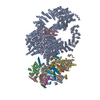
|
|---|---|
| 1 |
|
- 要素
要素
-タンパク質 , 8種, 8分子 ABCDFIJN
| #1: タンパク質 | 分子量: 353170.281 Da / 分子数: 1 / 由来タイプ: 天然 / 由来: (天然)  Homo sapiens (ヒト) / 細胞株: HeLa / 参照: UniProt: F2Z2U4 Homo sapiens (ヒト) / 細胞株: HeLa / 参照: UniProt: F2Z2U4 |
|---|---|
| #2: タンパク質 | 分子量: 66223.047 Da / 分子数: 1 / 由来タイプ: 天然 / 由来: (天然)  Homo sapiens (ヒト) / 参照: UniProt: O75529 Homo sapiens (ヒト) / 参照: UniProt: O75529 |
| #3: タンパク質 | 分子量: 88129.070 Da / 分子数: 1 / 由来タイプ: 天然 / 由来: (天然)  Homo sapiens (ヒト) / 参照: UniProt: Q8NEM7 Homo sapiens (ヒト) / 参照: UniProt: Q8NEM7 |
| #4: タンパク質 | 分子量: 78079.922 Da / 分子数: 1 / 由来タイプ: 組換発現 由来: (組換発現)  Homo sapiens (ヒト), (組換発現) Homo sapiens (ヒト), (組換発現)  unclassified Rhodococcus (バクテリア) unclassified Rhodococcus (バクテリア)遺伝子: SUPT7L, KIAA0764 / 発現宿主:  Homo sapiens (ヒト) / 参照: UniProt: O94864 Homo sapiens (ヒト) / 参照: UniProt: O94864 |
| #6: タンパク質 | 分子量: 67903.289 Da / 分子数: 1 / 由来タイプ: 天然 / 由来: (天然)  Homo sapiens (ヒト) / 参照: UniProt: Q9Y6J9 Homo sapiens (ヒト) / 参照: UniProt: Q9Y6J9 |
| #9: タンパク質 | 分子量: 33197.047 Da / 分子数: 1 / 由来タイプ: 天然 / 由来: (天然)  Homo sapiens (ヒト) / 参照: UniProt: O75486 Homo sapiens (ヒト) / 参照: UniProt: O75486 |
| #10: タンパク質 | 分子量: 37432.531 Da / 分子数: 1 / 由来タイプ: 天然 / 由来: (天然)  Homo sapiens (ヒト) / 参照: UniProt: Q96BN2 Homo sapiens (ヒト) / 参照: UniProt: Q96BN2 |
| #11: タンパク質 | 分子量: 95597.742 Da / 分子数: 1 / 由来タイプ: 天然 / 由来: (天然)  Homo sapiens (ヒト) / 参照: UniProt: O15265 Homo sapiens (ヒト) / 参照: UniProt: O15265 |
-Transcription initiation factor TFIID subunit ... , 3種, 3分子 EGH
| #5: タンパク質 | 分子量: 27654.861 Da / 分子数: 1 / 由来タイプ: 天然 / 由来: (天然)  Homo sapiens (ヒト) / 参照: UniProt: Q9HBM6 Homo sapiens (ヒト) / 参照: UniProt: Q9HBM6 |
|---|---|
| #7: タンパク質 | 分子量: 17948.467 Da / 分子数: 1 / 由来タイプ: 天然 / 由来: (天然)  Homo sapiens (ヒト) / 参照: UniProt: Q16514 Homo sapiens (ヒト) / 参照: UniProt: Q16514 |
| #8: タンパク質 | 分子量: 21731.248 Da / 分子数: 1 / 由来タイプ: 天然 / 由来: (天然)  Homo sapiens (ヒト) / 参照: UniProt: Q12962 Homo sapiens (ヒト) / 参照: UniProt: Q12962 |
-非ポリマー , 1種, 1分子 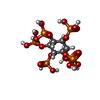
| #12: 化合物 | ChemComp-IHP / |
|---|
-詳細
| 研究の焦点であるリガンドがあるか | Y |
|---|---|
| 配列の詳細 | Portions of chains A, D and I were not fully discernible in the map, and so many of the residues ...Portions of chains A, D and I were not fully discernible in the map, and so many of the residues were modeled as unknown (UNK) due to not knowing the register in these regions. The full sequence of the chains are as follows. Chain A: MAFVATQGAT |
 ムービー
ムービー コントローラー
コントローラー



 UCSF Chimera
UCSF Chimera


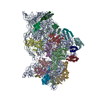
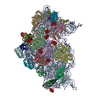


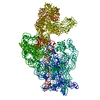

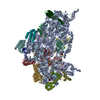


 PDBj
PDBj








